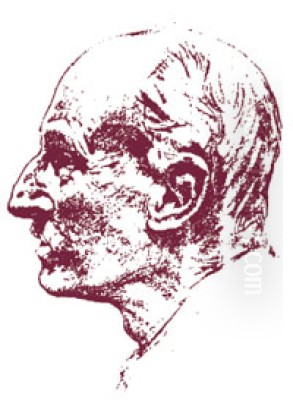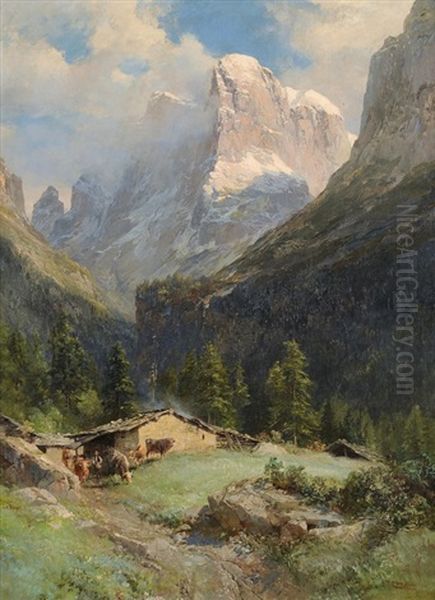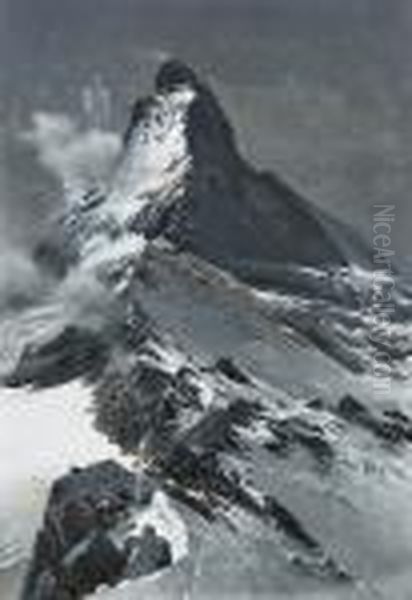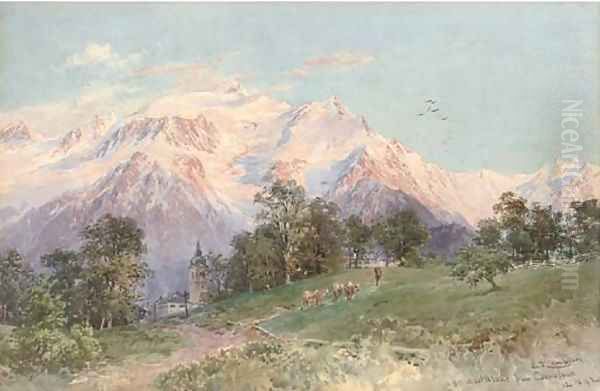
Edward Theodore Compton stands as a unique figure in the annals of art history, a man whose life and work were inextricably linked to the formidable majesty of the mountains. Born British but spending his most productive years in Germany and Austria, Compton became one of the foremost painters of the Alpine landscape. Yet, he was not merely an observer; he was an active participant, a skilled and daring mountaineer who experienced the high peaks firsthand. This dual identity as both artist and Alpinist infused his work with a remarkable authenticity, capturing not just the visual splendour but also the very spirit of the alpine world. His prolific output serves as a breathtaking visual chronicle of the mountains he loved and climbed.
Early Life and Artistic Awakening
Edward Theodore Compton was born on July 29, 1849, in Stoke Newington, London. His father, Theodore Compton, worked as an insurance agent but harboured a deep appreciation for the arts, being something of an amateur painter himself. This familial environment likely nurtured young Edward's burgeoning artistic inclinations. From the tender age of 14, he began dedicated studies from nature, honing his observational skills and developing a sensitivity to the nuances of the natural world.
His formal art education included periods at various London institutions, including the Leigh's School of Art and potentially brief attendance at the Royal Academy schools, though he largely developed his skills through rigorous self-teaching and direct observation. A pivotal moment came in 1867 when the Compton family relocated to Germany, settling in the city of Darmstadt. This move marked the beginning of Compton's lifelong connection with the German-speaking world and its landscapes. He continued his artistic development, immersing himself in the German art scene, initially in Darmstadt and later moving towards the artistic hub of Munich.
The Call of the Mountains

While Compton was already developing as a landscape painter, a specific event cemented his lifelong passion for the high mountains. Around 1868 or 1869, during a visit to the Bernese Oberland in Switzerland, he was profoundly struck by the dramatic beauty and overwhelming scale of the peaks. Legend has it that a particular view, perhaps of the Eiger, Mönch, and Jungfrau, ignited an inspiration that would define his career. He resolved then not merely to paint the mountains from afar but to explore them intimately, to climb them, and to translate that direct, physical experience onto canvas.
This decision set him apart from many landscape painters of his era. He sought more than picturesque views; he sought the truth of the mountains, their geological structure, the play of light on rock and ice, the feeling of altitude and atmosphere. This commitment required immense physical effort and courage, bridging the gap between the studio artist and the adventurous explorer. He soon settled near Lake Starnberg in Bavaria, placing himself strategically close to the Alpine ranges that would become his primary subject and lifelong obsession.
A Life Between Easel and Ice Axe: The Mountaineer
Compton's dedication to mountaineering was no mere hobby; it was a serious pursuit that paralleled his artistic endeavours. He became a highly accomplished Alpinist during a period often referred to as the Silver Age of Alpinism, following the initial conquest of many major peaks. Over his lifetime, he is credited with completing over 300 significant climbs throughout the Alps and other ranges.
His mountaineering achievements were substantial. Remarkably, he participated in at least 27 first ascents, pioneering new routes on challenging peaks. One of his most celebrated first ascents was the Cima di Brenta (3151m) in the Brenta Dolomites, climbed in 1882 with Alberto de Falkner and guide Matteo Nicolussi. He also made the first ascent of the Torre di Brenta. His climbing resume included ascents of iconic peaks like the Grossglockner, the Ortler, and numerous challenging climbs in the Dolomites, the Bernese Oberland, the Pennine Alps, and the Mont Blanc massif.
Compton often climbed with leading Alpinists of his day. His regular partners included renowned figures such as Karl Blodig, the first person documented to have climbed all Alpine peaks over 4,000 meters. He also shared ropes with other significant climbers like Ludwig Purtscheller, the Zsigmondy brothers (Emil and Otto), and Theodor Wundt. These collaborations underscore his standing within the elite mountaineering community. His deep involvement was further evidenced by his membership in the prestigious German and Austrian Alpine Club (Deutscher und Österreichischer Alpenverein - DuÖAV), a central organization for mountaineering in the region.
The Alpine Vision: Compton's Artistic Style

Compton's artistic style evolved throughout his career but remained anchored in a commitment to realism and topographical accuracy, elevated by a masterful handling of light and atmosphere. While his early work showed influences from British Romantic painters like J.M.W. Turner, particularly in the dramatic rendering of light and weather, he moved towards a more objective, yet still deeply evocative, portrayal of mountain scenery. He absorbed the lessons of naturalism prevalent in the 19th century, influenced perhaps by the detailed geological focus advocated by figures like John Ruskin.
He is often associated with Realism, yet his work transcends mere photographic reproduction. Compton possessed an extraordinary ability to capture the specific quality of alpine light – the crisp clarity of high altitude, the dramatic contrasts of sun and shadow on snow and rock, the ethereal glow of dawn or dusk on glaciers. While working during the era of Impressionism, his style differs significantly. Unlike the Impressionists who often dissolved form in favour of capturing fleeting light effects, Compton maintained a strong sense of structure and geological detail. His mountains feel solid, immense, and geologically convincing, even as they are bathed in atmospheric light.
Compton worked proficiently in both oils and watercolour. His watercolours are particularly admired for their freshness, luminosity, and technical skill, often executed en plein air (outdoors) during his expeditions, capturing immediate impressions. His oil paintings, often developed from sketches and studies made on location, allowed for greater detail and depth, conveying the monumental weight and grandeur of the peaks. His compositions frequently emphasize the vast scale of the mountains, often dwarfing human figures or settlements, evoking feelings of awe and the sublime power of nature, reminiscent of the earlier German Romantic painter Caspar David Friedrich, though Compton's approach was less overtly symbolic.
Masterworks and Signature Subjects
Edward Theodore Compton's output was vast, numbering over 1,000 paintings and potentially many more sketches and illustrations. Pinpointing single "masterworks" is challenging given the consistent quality and sheer volume of his production. However, certain subjects and specific paintings stand out as representative of his oeuvre.
Views of the Matterhorn (4478m) were a recurring subject, captured from various angles and under different light conditions, showcasing its iconic pyramid shape with both accuracy and dramatic flair. Similarly, he painted Mont Blanc (4808m), the highest peak in the Alps, numerous times, often focusing on the interplay of glaciers, rock buttresses, and changing weather around its massive form.

His depictions of the Dolomites are particularly noteworthy. Paintings like those featuring the Cima di Brenta or the Tre Cime di Lavaredo capture the unique verticality and distinctive rock formations of this region with exceptional skill. He masterfully rendered the characteristic pale dolomite rock, contrasting it with deep shadows and sunlit snowfields.
The Grossglockner (3798m), Austria's highest peak, was another favourite subject, often depicted with its distinctive Pasterze Glacier. Compton's paintings of these major peaks were not just portraits of mountains; they were studies in geology, light, and the profound emotional impact of the high alpine environment. His works convey majesty, solitude, the inherent dangers, and the breathtaking beauty he experienced firsthand. He often included small figures of climbers or chalets to provide scale, emphasizing the overwhelming dominance of nature.
Compton's Place in Art History
Edward Theodore Compton occupies a significant niche within the tradition of European landscape painting, particularly as a specialist in alpine art. His work bridges the gap between the Romantic tradition and later, more objective approaches to landscape. While influenced by the atmospheric drama of Turner and the detailed naturalism promoted by Ruskin, he forged his own distinct path.
He can be compared to other prominent mountain painters. The Swiss artist Alexandre Calame was an earlier 19th-century painter known for his dramatic Alpine scenes, though Compton's work often displays a greater sense of immediacy and topographical precision gained from his own climbing. Contemporaries included the Italian Symbolist Giovanni Segantini, who also painted Alpine subjects but infused them with a more mystical, allegorical quality. Another contemporary painter-mountaineer was the Frenchman Gabriel Loppé, known especially for his high-altitude paintings, sharing Compton's commitment to direct experience.
In the context of landscape painting depicting grand natural spectacles, his work resonates with that of American painters like Albert Bierstadt and Thomas Moran, who captured the monumental landscapes of the American West, although Compton's focus remained steadfastly on the European mountains he knew so intimately.
Compton's influence extended to subsequent generations of alpine painters. Artists like Ernst Heinrich Platz and Karl Arnold clearly drew inspiration from Compton's style and subject matter. His dedication to accuracy and his ability to convey the specific character of different mountain ranges set a standard. His own children, Edward Harrison Compton (1881-1960) and Dora Compton, also became painters, continuing the family's artistic engagement with mountain landscapes, often working alongside their father. He was also associated with artistic and mountaineering circles, including his membership in the DuÖAV and connections with groups like the Tödi section of the Swiss Alpine Club.
Beyond the Alps
While the Alps were undoubtedly Compton's primary muse, his artistic and adventurous spirit led him further afield. His travels provided material for paintings depicting other mountainous and dramatic landscapes across Europe and even beyond. He journeyed to and painted the rugged scenery of the High Tatras in present-day Slovakia and Poland, capturing their distinct character.
His travels also took him to Norway, where he painted the dramatic fjords and coastal scenes, including views of the North Cape. The Scottish Highlands, with their moody atmosphere and rolling peaks, also featured in his work. He ventured to Corsica, capturing its mountainous interior, and explored parts of Spain and North Africa, always seeking out landscapes that resonated with his love for dramatic natural forms. These excursions broadened his portfolio, demonstrating his ability to apply his observational skills and artistic style to diverse environments, although the Alps remained the heartland of his artistic output.
Family, Legacy, and Recognition
Edward Theodore Compton married Auguste Plotz in 1874, and they settled permanently in Feldafing on Lake Starnberg, Bavaria. Their family life was intertwined with his artistic and mountaineering pursuits. As mentioned, two of his children, Edward Harrison Compton and Dora Compton Keelher, followed in his footsteps as artists, specializing in similar landscape subjects. His son, E. Harrison, often collaborated with him and developed a style closely related to his father's, sometimes leading to confusion in attribution.
Compton continued to paint and climb actively until later in life. He remained a respected figure in both the art world and the mountaineering community. His works were exhibited widely, including at the Royal Academy in London and major exhibitions in Munich and Vienna, gaining international recognition. He also provided numerous illustrations for Alpine journals and books, disseminating his vision of the mountains to a wider audience.
Edward Theodore Compton passed away on March 22, 1921, in Feldafing, the Bavarian town that had been his home for nearly five decades. His contribution was honoured posthumously. A mountain hut in the Dolomites, the Rifugio Re Alberto Primero (Gartlhütte), originally known as the Comptonhütte, acknowledges his connection to the region, although it was primarily named after King Albert I of Belgium. More directly, a peak in the Berchtesgaden Alps, the Comptonspitze, bears his name, a fitting tribute to a man who dedicated his life to exploring and depicting the high places. Today, his paintings are held in numerous public and private collections and are highly sought after for their beauty, accuracy, and the unique perspective of an artist who truly knew his subject from the inside out.
Conclusion: An Authentic Vision
Edward Theodore Compton's legacy is that of an artist who achieved a rare synthesis of direct physical experience and masterful artistic representation. He was not content to view the mountains from a distance; he climbed them, felt their textures, breathed their thin air, and faced their challenges. This profound intimacy with his subject matter imbues his paintings with an unparalleled authenticity and power. His vast body of work provides not only aesthetically stunning views but also a valuable topographical record of the Alps and other ranges as they were in the late 19th and early 20th centuries. He remains a towering figure in the specialized genre of alpine art, celebrated for his technical skill, his prolific output, and his unwavering dedication to capturing the sublime truth of the world's high mountains.